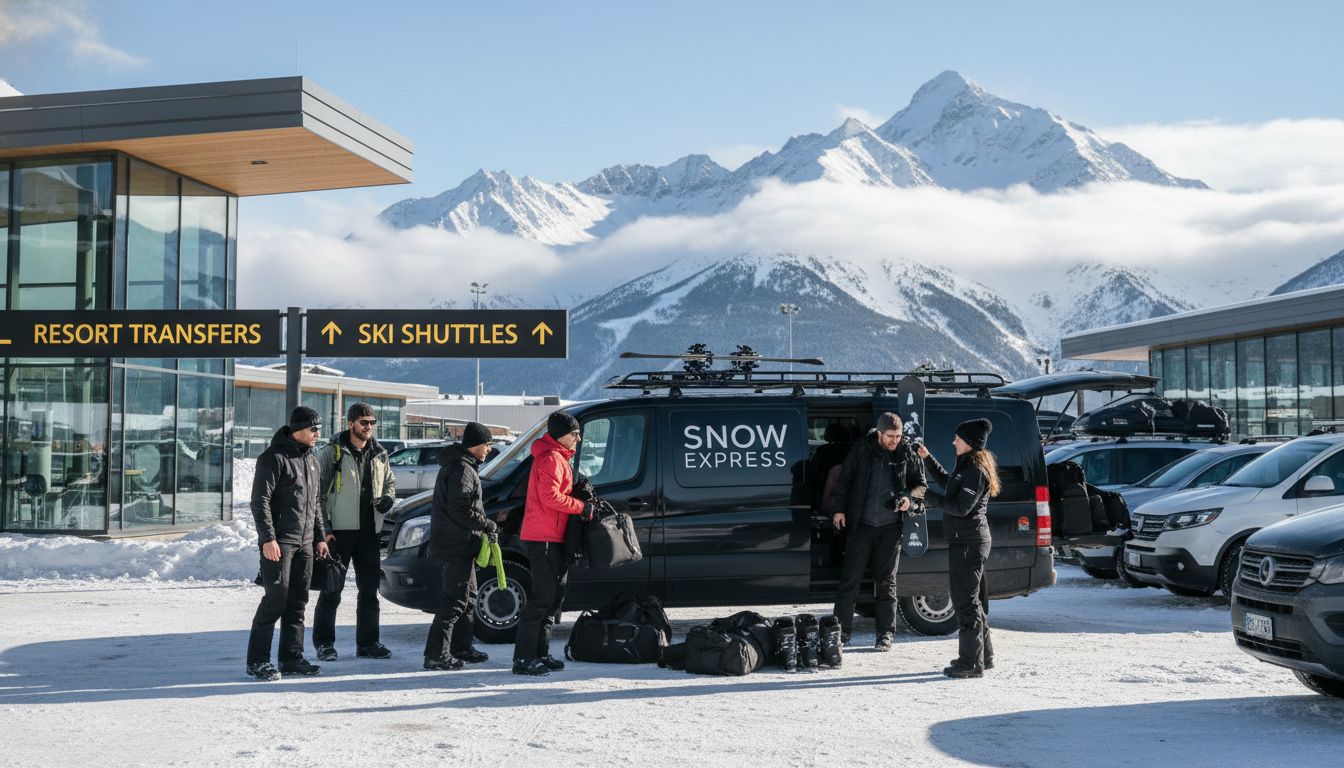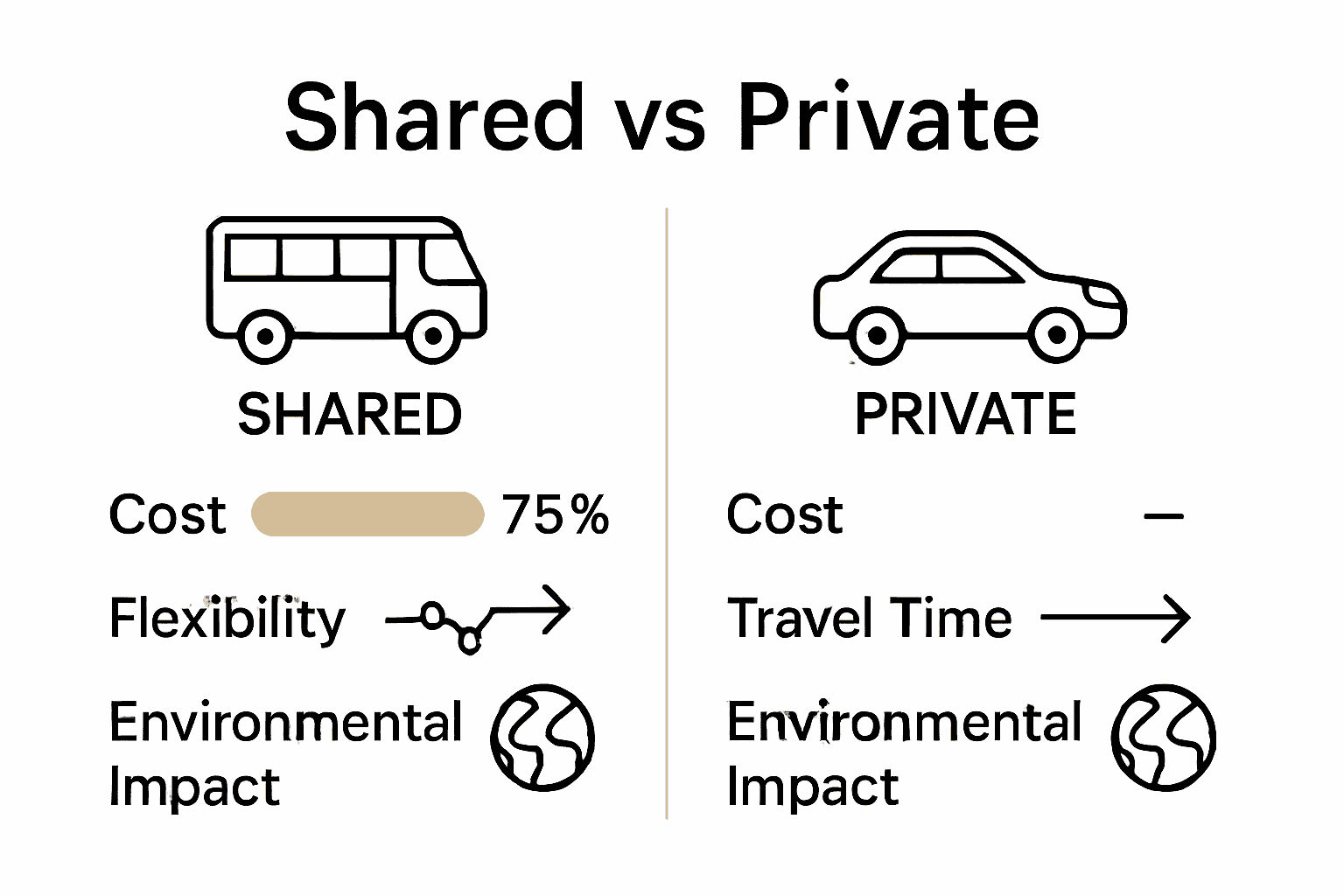What Is a Shared Ski Transfer? Complete Overview
- plodh79
- Nov 9
- 7 min read

More than 50 percent of travelers say transportation costs are the biggest barrier to booking a ski holiday. Shared ski transfers offer an affordable way to reach mountain resorts without sacrificing comfort or convenience. With modern services coordinating passengers heading to similar destinations, it’s possible to cut expenses and still arrive stress-free. This article clears up common myths and explains everything you need to know about shared ski transfers—so you can pick the right option and get more value out of your trip.
Table of Contents
Key Takeaways
Point | Details |
Cost-Effective Travel | Shared ski transfers can save travelers up to 50% compared to private transfers, making them a budget-friendly option. |
Comfort and Coordination | Professional services ensure comfortable rides with optimized routes to minimize travel time while accommodating multiple passengers. |
Social Opportunities | Shared transfers offer chances to meet fellow travelers, enhancing the overall experience while reducing individual carbon footprints. |
Advance Booking Recommended | To ensure a seamless experience, book shared transfers 2-4 weeks in advance, especially during peak season. |
Defining Shared Ski Transfers and Common Myths
A shared ski transfer transforms your airport-to-resort journey from a potential hassle into an efficient, budget-friendly travel experience. According to skiworld.co.uk, these transfers involve passengers traveling together in the same vehicle, typically moving between airports and ski destinations with multiple pick-ups and drop-offs along the route.
Unlike private transfers that cater exclusively to your group, shared transfers combine travelers heading in similar directions. This approach allows skiers to split transportation costs while enjoying a comfortable ride. Imagine boarding a well-maintained shuttle with fellow winter sports enthusiasts, sharing the excitement of an upcoming ski adventure, and reducing your overall travel expenses simultaneously.
Common myths about shared ski transfers often discourage travelers, but the reality is far more appealing. Many people mistakenly believe shared transfers mean uncomfortable, overcrowded vehicles or significantly longer travel times. However, professional transfer services carefully plan routes to minimize additional travel time and ensure passenger comfort. They strategically coordinate pick-ups to create efficient routes that don’t dramatically extend individual journey times.

Key benefits of shared ski transfers include:
Cost-effective transportation compared to private transfers
Opportunity to meet fellow travelers
Reduced individual carbon footprint
Professional, reliable service
Stress-free travel from airport to resort
To help you better understand your options, we have a guide on understanding the role of ski transfers that provides additional insights into making the most of your mountain transportation.
Types of Shared Ski Transfers Available
Shared ski transfers come in several distinct varieties, each designed to meet different traveler needs and preferences. While the core concept remains consistent - combining multiple passengers traveling in the same direction - the specific types can vary significantly in their approach and service level.
Standard Shuttle Transfers represent the most common shared ski transfer option. These shuttle services operate on predetermined routes, picking up and dropping off passengers at multiple locations. Passengers typically share a minibus or mid-sized vehicle, with routes carefully planned to minimize additional travel time. These transfers are ideal for budget-conscious travelers who don’t mind a slightly longer journey in exchange for reduced transportation costs.
Resort Scheduled Transfers offer a more structured approach. These services run at specific times throughout the day, often synchronized with major airport arrival and departure windows. They provide a reliable, predictable option for travelers who prefer knowing exactly when their transportation will arrive. Most resort scheduled transfers use larger vehicles like coaches or minibuses, allowing for more passengers and potentially lower individual costs.
Another popular option is the Private Group Shared Transfer, which combines elements of both private and shared services. In this model, a vehicle is booked by a group of travelers who know each other - perhaps a group of friends, a ski club, or colleagues - allowing them to split costs while maintaining a more personalized travel experience.
Key characteristics of shared ski transfers include:
Flexible pickup locations
Cost-effective pricing
Reduced environmental impact
Social interaction opportunities
Professional driver services
To explore more about planning your ski transfer, check out our guide on ski trip transfer planning that can help you navigate your transportation options more effectively.
How Shared Ski Transfers Operate
Shared ski transfers function through a sophisticated coordination process designed to maximize efficiency and passenger convenience. At the core of these services is a carefully orchestrated system that matches travelers heading in similar directions, creating an optimized transportation solution that balances cost-effectiveness with passenger comfort.
The operational process typically begins with advanced booking and route planning. Transfer companies use sophisticated software to cluster passengers with compatible routes and destinations. This means when you book a shared transfer, the company analyzes existing passenger routes to determine the most efficient pickup and drop-off sequence. Passengers are strategically grouped to minimize additional travel time while ensuring everyone reaches their specific destination.
Once the route is mapped, the transfer service coordinates vehicle selection based on the number of passengers and their specific needs. This might involve using minibuses, coaches, or specially equipped vehicles that can accommodate ski equipment. Professional drivers who are familiar with mountain routes play a crucial role, managing complex navigation through potentially challenging winter driving conditions while maintaining passenger safety and comfort.
The actual transfer experience involves several key steps:
Initial passenger pickup at designated airport locations
Coordinated route optimization
Multiple drop-offs at different ski resorts or accommodations
Professional handling of luggage and ski equipment
Real-time route adjustments if needed
For travelers looking to understand more about managing transfer costs, our guide on cost breakdown of ski transfers offers deeper insights into the financial considerations of these services.
Booking Process and Key Requirements
Booking a shared ski transfer involves a straightforward yet detailed process designed to ensure smooth and personalized transportation. Travelers must provide specific information that helps transfer services create the most efficient route and accommodate individual needs, transforming what could be a complicated travel arrangement into a seamless experience.
The essential booking requirements typically include comprehensive passenger and travel details. You’ll need to provide your complete flight information, including arrival and departure times, flight numbers, and the specific airport terminal. Additionally, travelers must specify their final destination - whether it’s a ski resort, hotel, or specific address. This precision allows transfer companies to optimize route planning and ensure accurate pickup and drop-off locations. Most services also require the total number of passengers, including any children or infants who might need special accommodations like car seats.
Timing plays a critical role in shared ski transfer bookings. Most services recommend booking well in advance, particularly during peak ski season when demand is high. Ideal booking windows typically range from 2-4 weeks before your travel date, though some flexible services accommodate last-minute reservations. Advance booking not only guarantees your spot but also allows transfer companies to more effectively cluster passengers with compatible routes, potentially reducing individual travel costs.
Key documentation and preparation steps include:
Valid passport or government-issued ID
Detailed flight confirmation
Exact destination address
Contact information for all passengers
Special requirement notifications (accessibility needs, equipment)
Confirmation of luggage and ski equipment
For travelers seeking more detailed guidance on planning their ski transfer, our ski trip transfer planning guide provides comprehensive insights to help you navigate the booking process with confidence.
Costs, Pros and Cons Compared to Private Transfers
The decision between shared and private ski transfers involves carefully weighing multiple factors, with cost being a primary consideration. According to theexeterdaily.co.uk, shared transfers can save travelers almost half the cost compared to hiring a private vehicle, making them particularly attractive for solo travelers and couples seeking budget-friendly transportation options.
Cost Comparison reveals significant financial advantages for shared transfers. While private transfers offer exclusive transportation, they come with a substantially higher price tag. Shared transfers distribute the total vehicle cost across multiple passengers, dramatically reducing individual expenses. However, this cost-saving approach does introduce some trade-offs. The most notable compromise is potentially longer travel times, as the shuttle must accommodate multiple pick-up and drop-off locations, which can extend the overall journey duration compared to a direct private transfer.
The pros and cons of shared transfers become more nuanced when examining individual traveler needs. Private transfers provide unparalleled flexibility, allowing immediate departure, direct routes, and personalized service.

Shared transfers, conversely, offer a more structured but economical alternative. They’re ideal for budget-conscious travelers, those comfortable with slight schedule variations, and individuals who don’t mind sharing transportation with other ski enthusiasts.
Key comparison points between shared and private transfers:
Cost: Shared transfers 50% cheaper
Flexibility: Private transfers more adaptable
Travel Time: Shared transfers potentially longer
Environmental Impact: Shared transfers more eco-friendly
Social Experience: Shared transfers offer potential interaction
Luggage Handling: Private transfers typically more personalized
For travelers looking to optimize their transfer strategy, our guide on how to save on ski transfers provides additional insights into making the most cost-effective transportation choices.
Discover a Premium Alternative to Shared Ski Transfers for Your Geneva Ski Journey
The article highlights key challenges of shared ski transfers such as longer travel times, multiple stops, and less flexibility that can affect your comfort and schedule during a ski holiday. If you’re looking for a more personalized and stress-free way to reach your resort without sacrificing convenience or breaking your budget, consider booking a private ski transfer with Alpy Transfers. Our service guarantees professional drivers, modern vehicles, and punctual pickups that save you time and reduce travel hassle.

Choose the smarter alternative to shared shuttles by securing your private transfer now and enjoy a seamless, direct ride from Geneva airport to your ski accommodation. Visit https://alpy.eu to customize your trip with easy online booking, transparent pricing, and options tailored to your exact travel needs. Make your ski holiday transport part of the premium experience you deserve today.
Frequently Asked Questions
What is a shared ski transfer?
A shared ski transfer is a transportation service where multiple passengers travel together in the same vehicle, typically from airports to ski resorts, with several pick-up and drop-off points along the route.
How do shared ski transfers operate?
Shared ski transfers operate through advanced booking and route planning, where transfer companies cluster passengers with similar destinations to optimize pickup and drop-off sequences, ensuring cost-effectiveness and comfort.
What are the benefits of choosing a shared ski transfer?
The benefits of shared ski transfers include cost savings, opportunities to meet fellow travelers, reduced environmental impact, reliable professional service, and a stress-free travel experience from the airport to the resort.
What do I need to book a shared ski transfer?
When booking a shared ski transfer, you typically need to provide flight information, destination address, total number of passengers, and any special requirements such as accessibility needs or specific accommodations for children.
Recommended

Comments